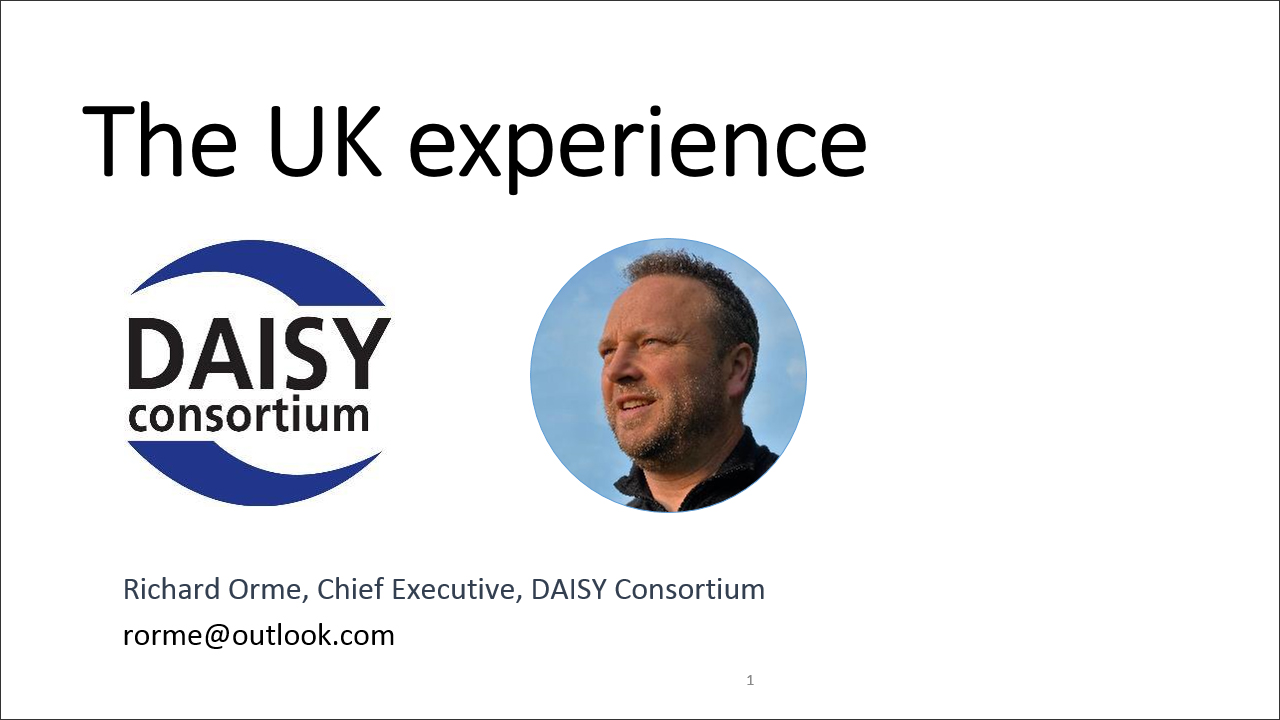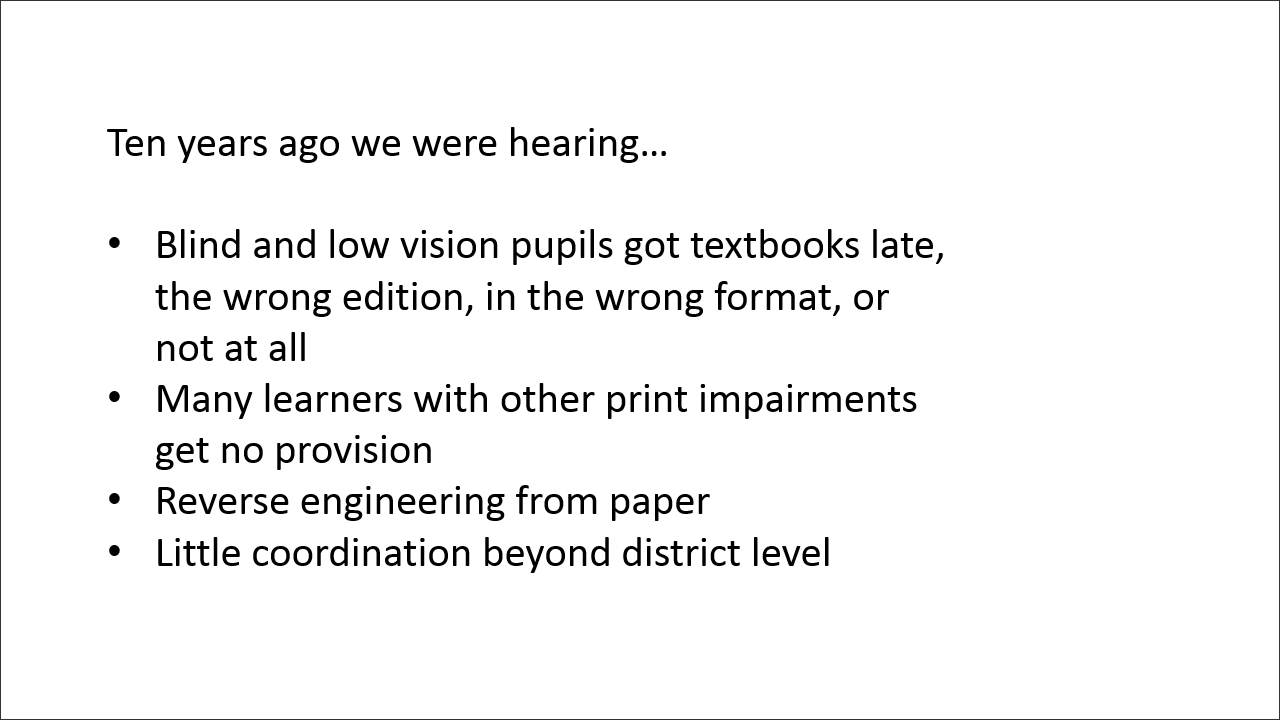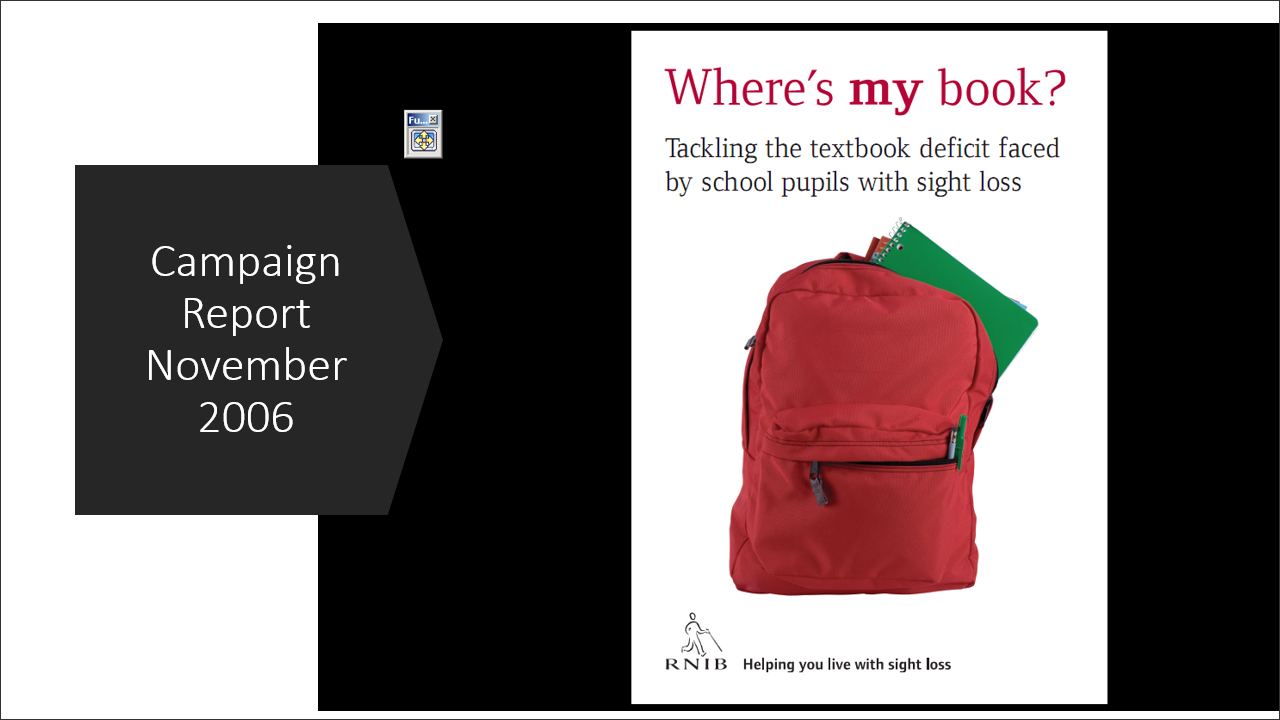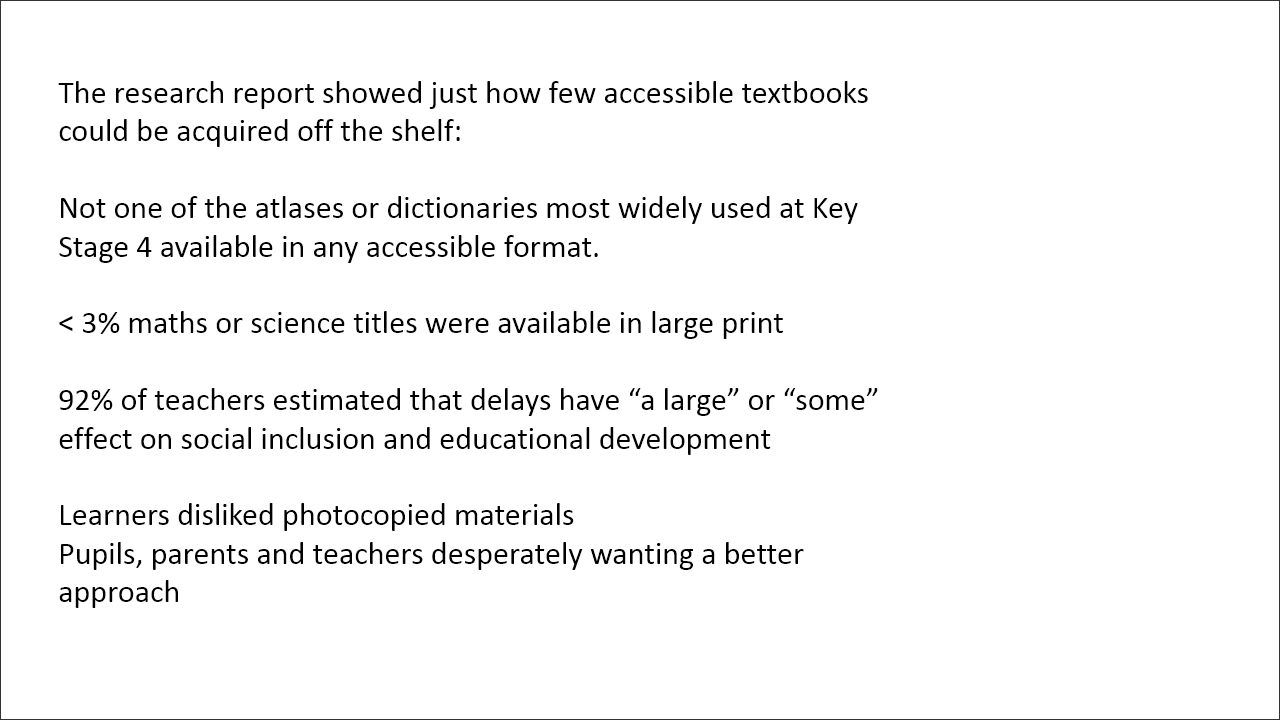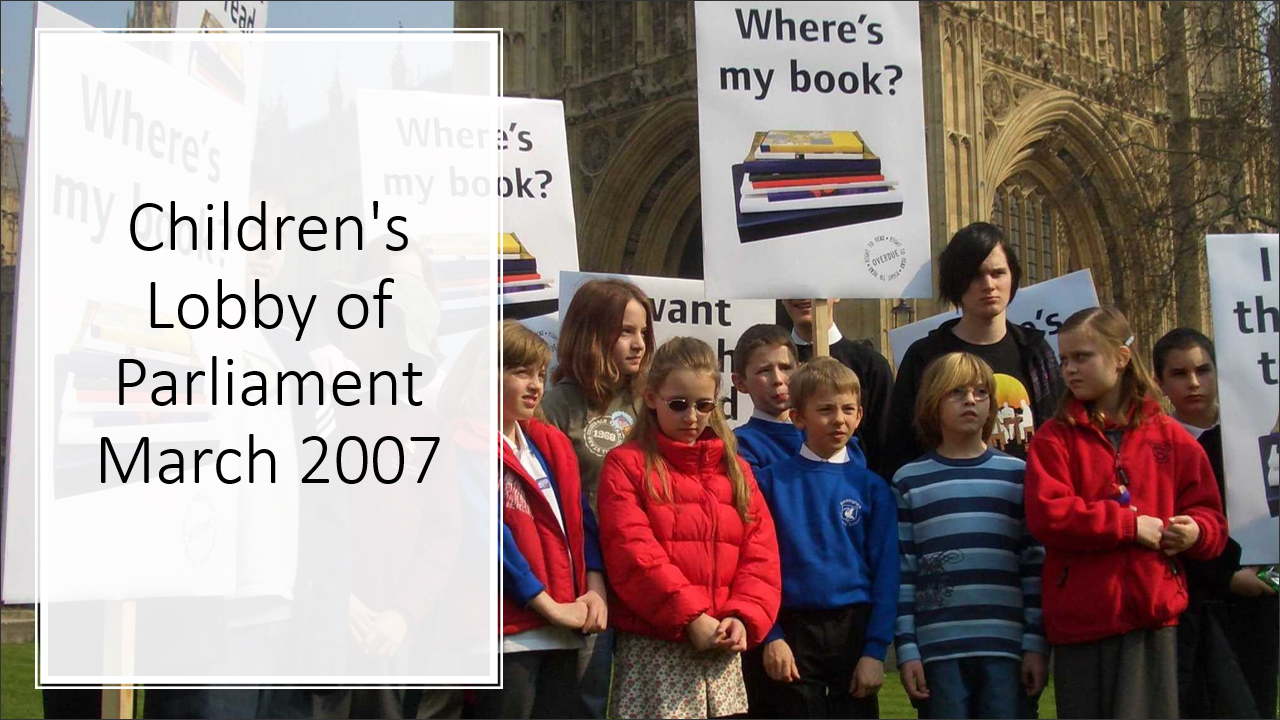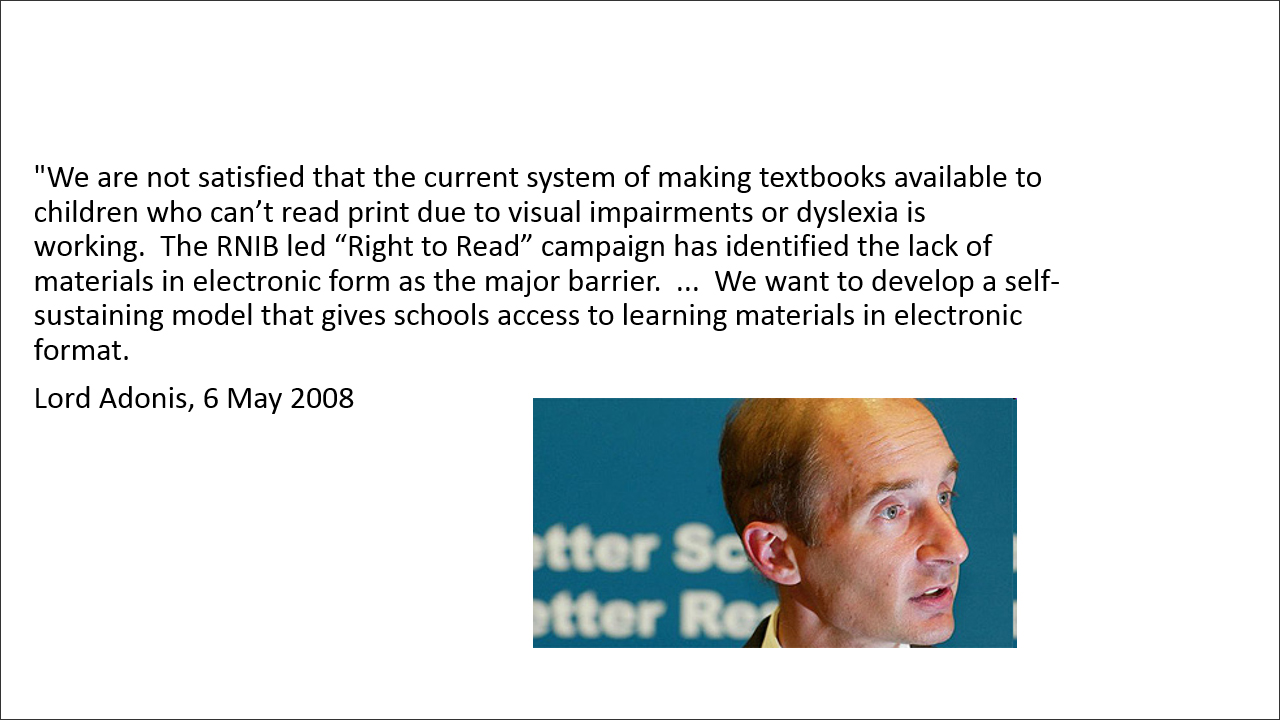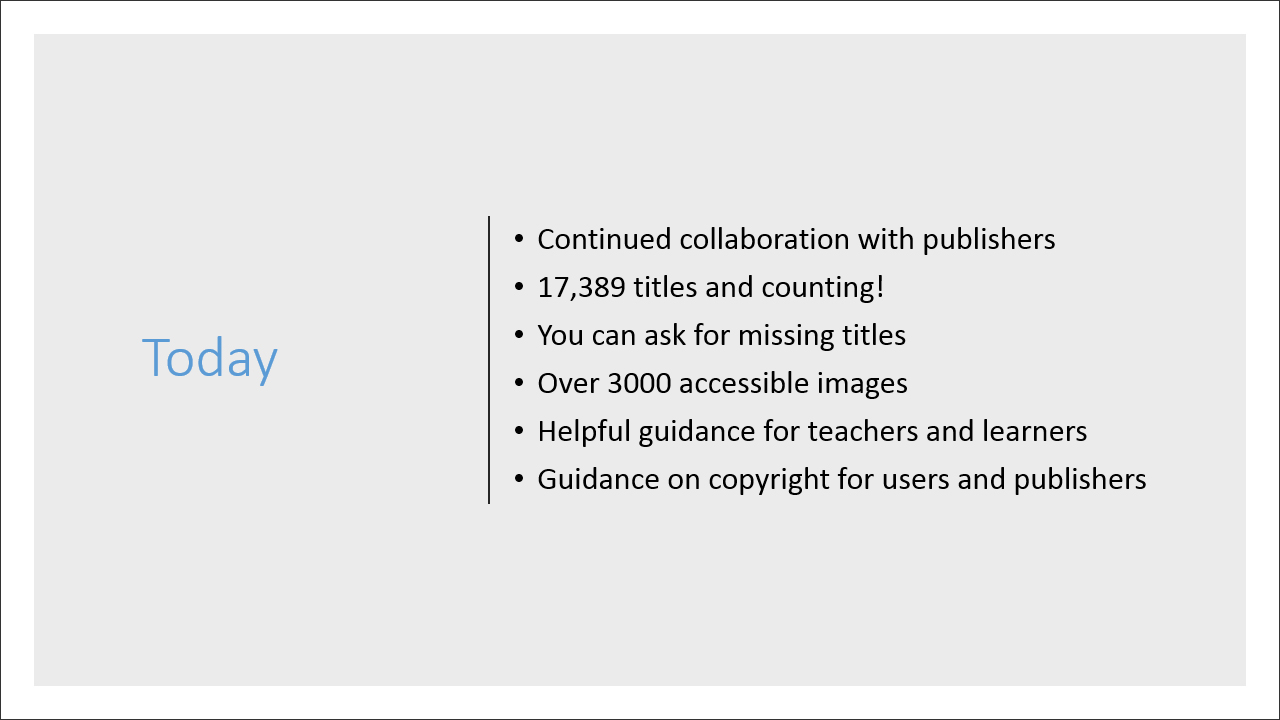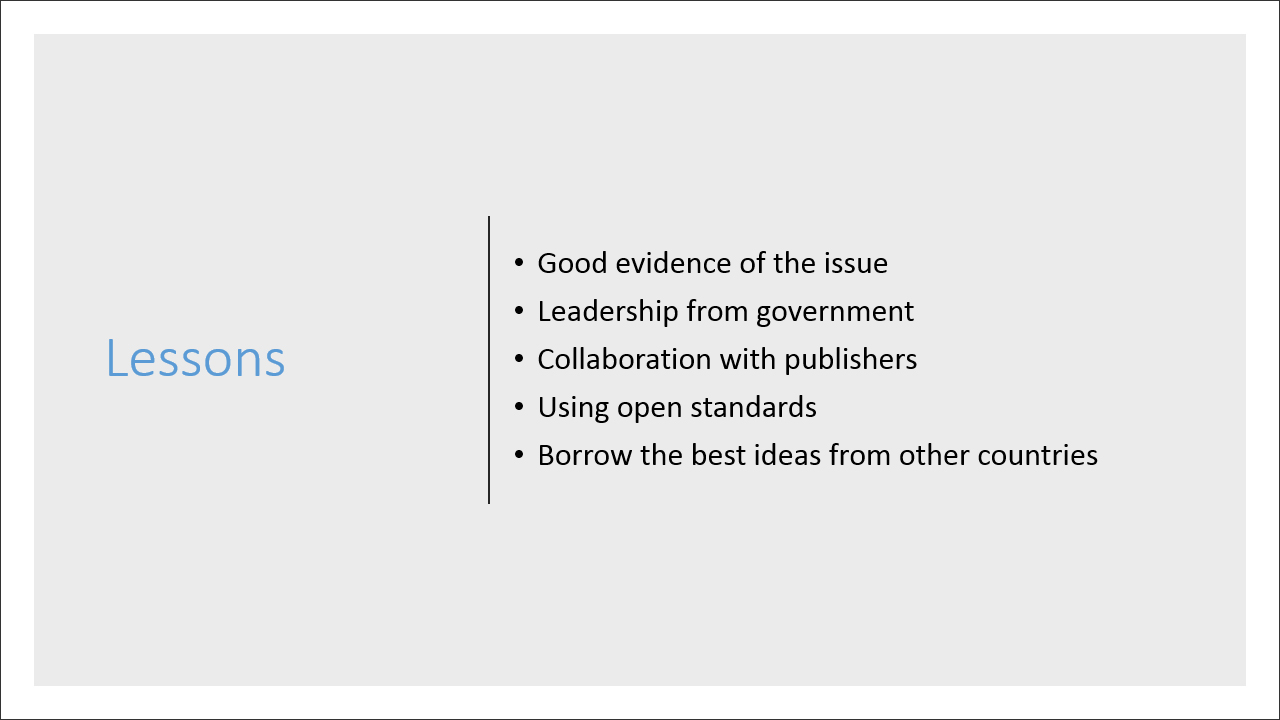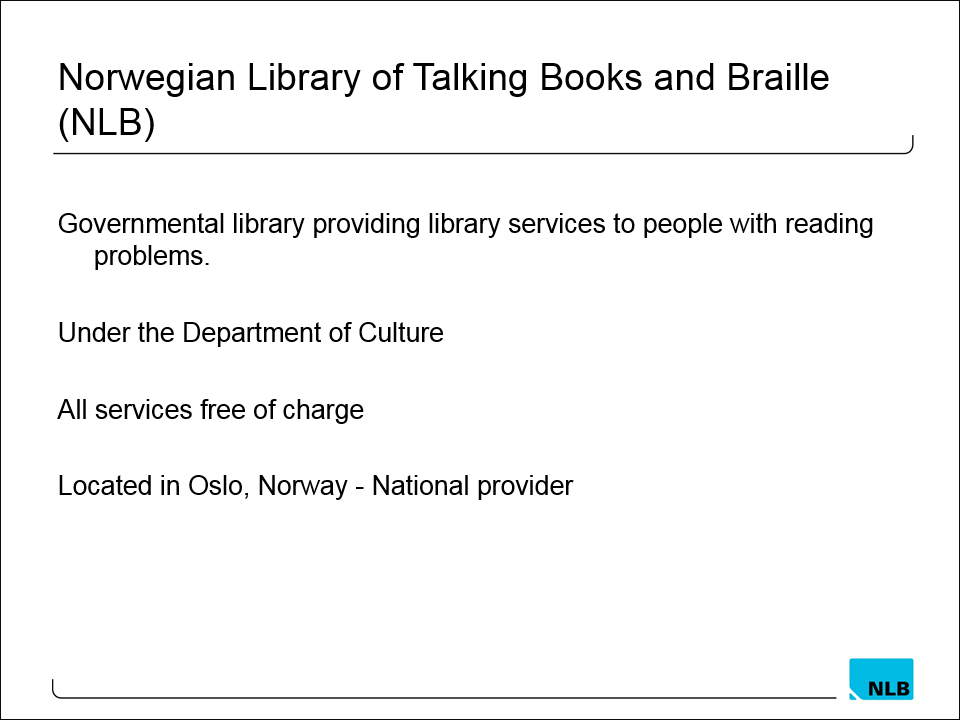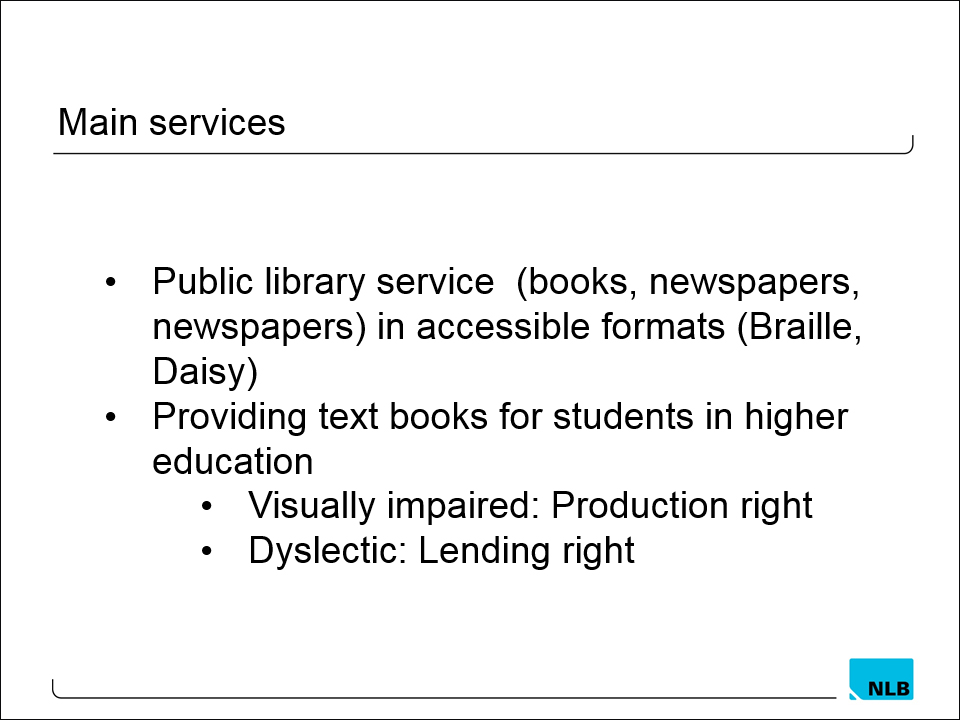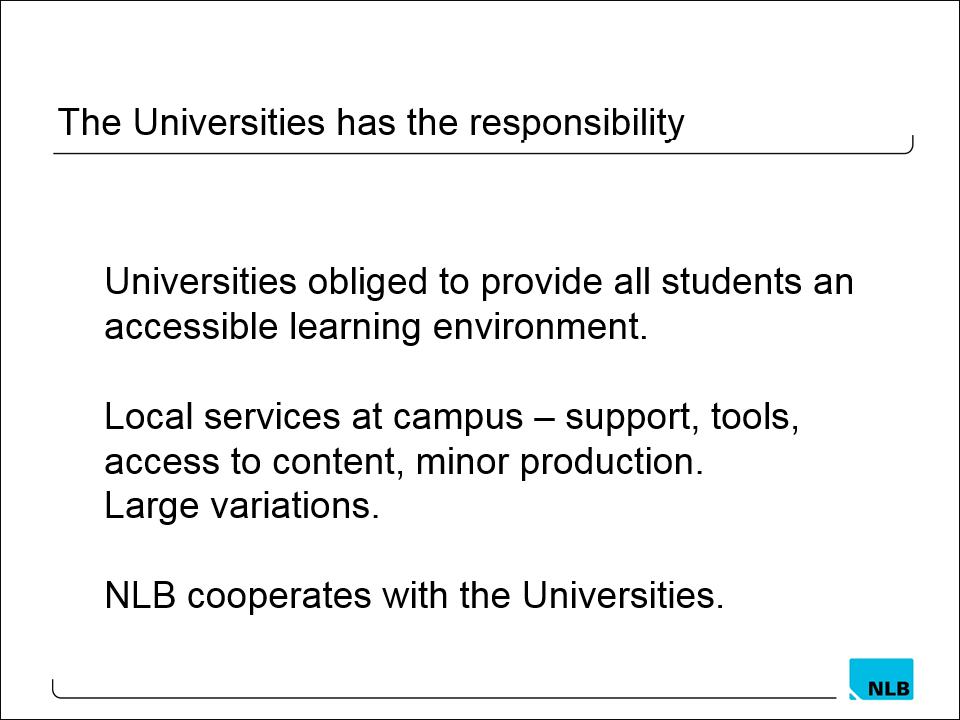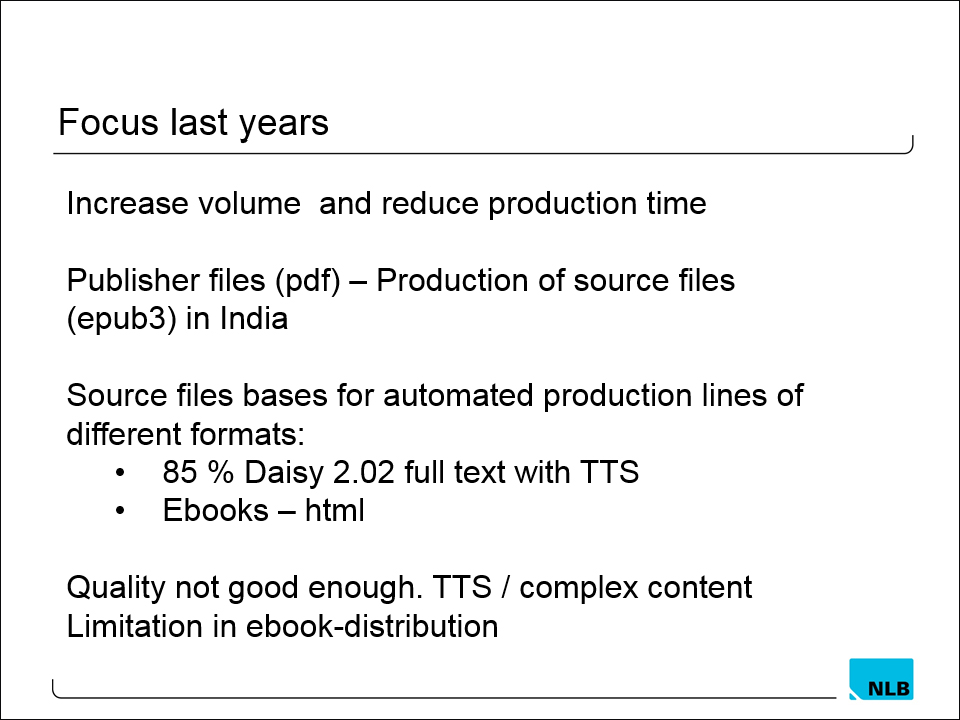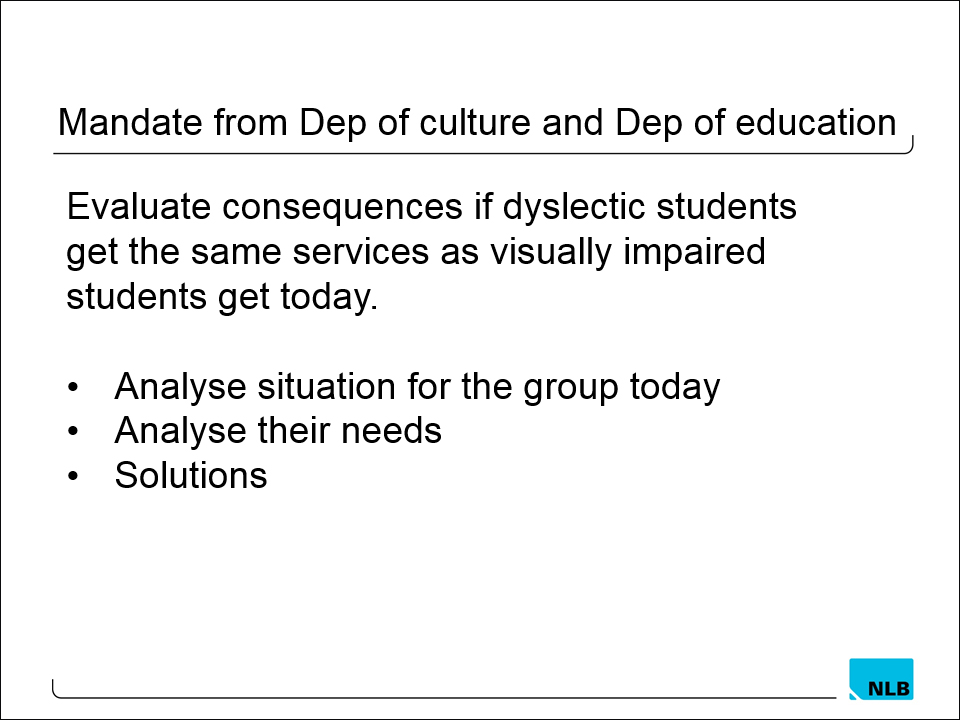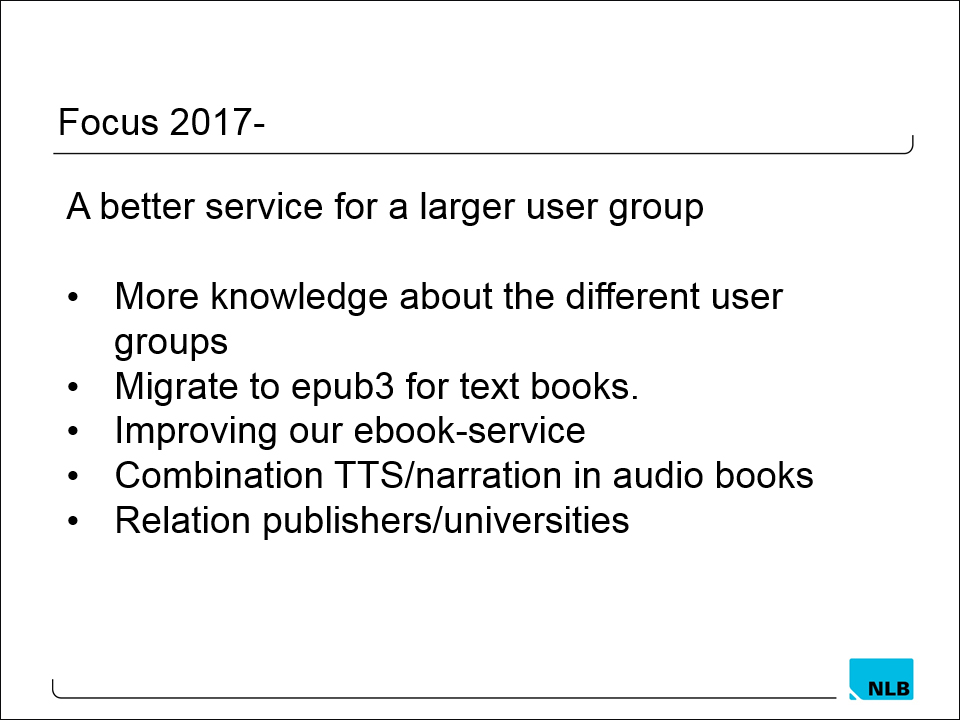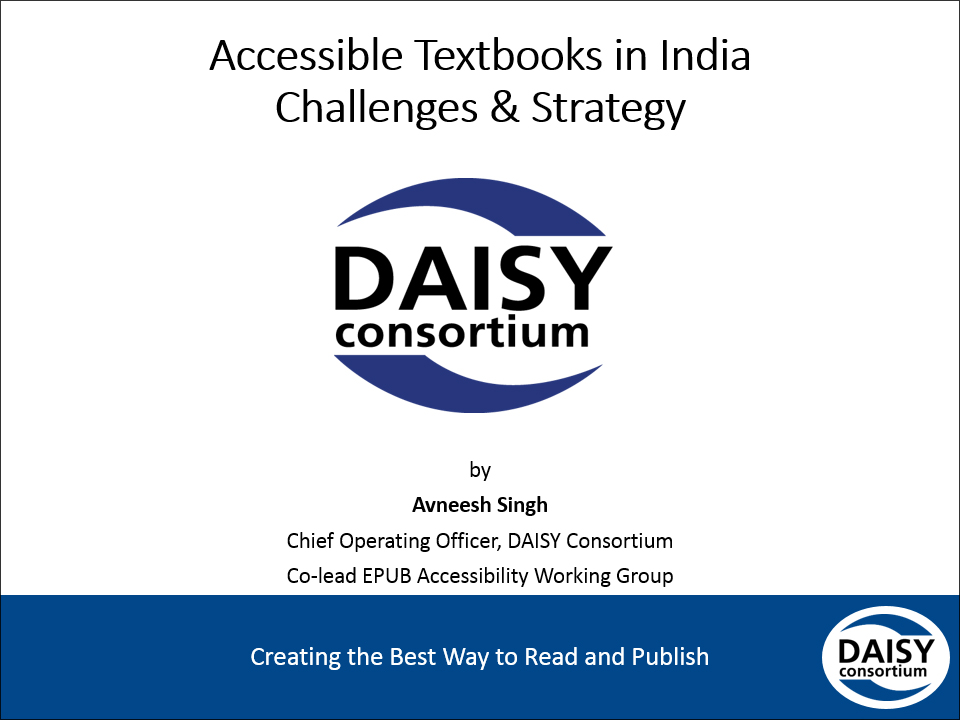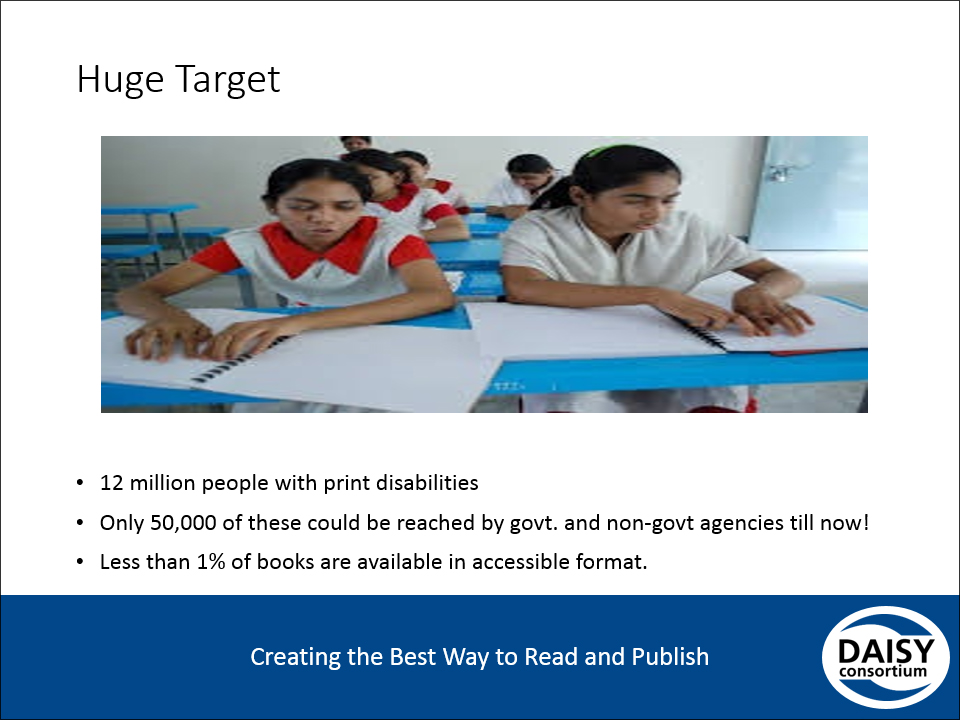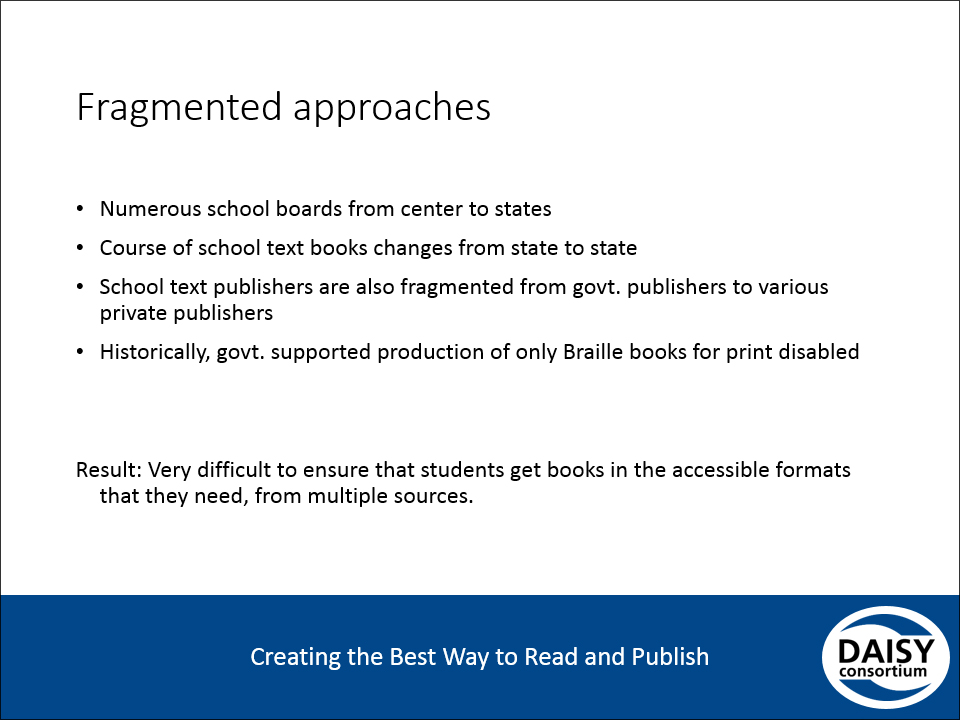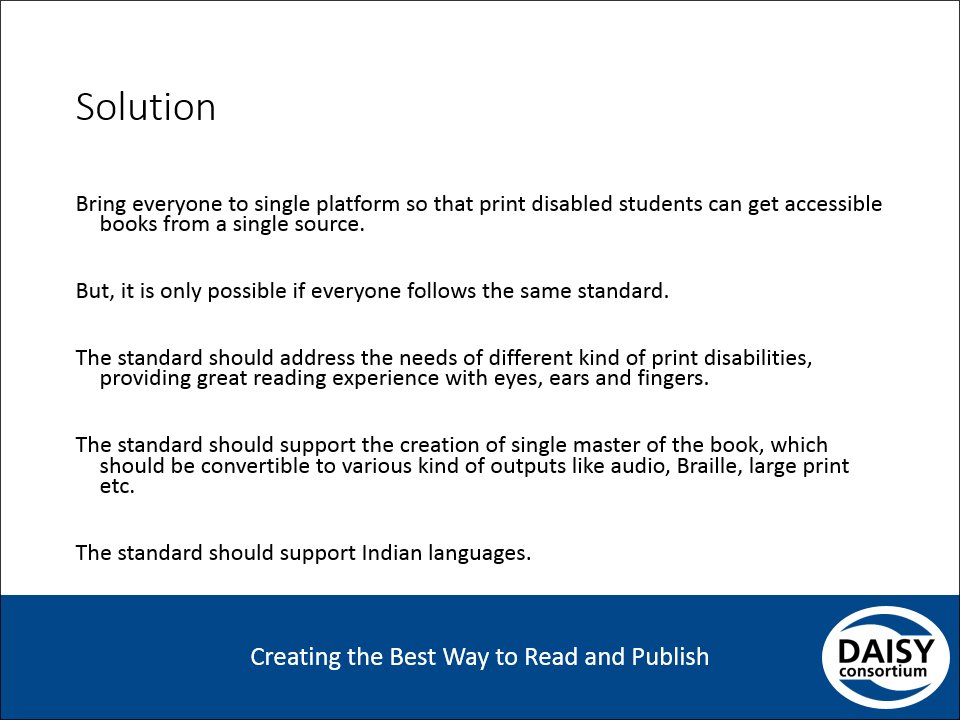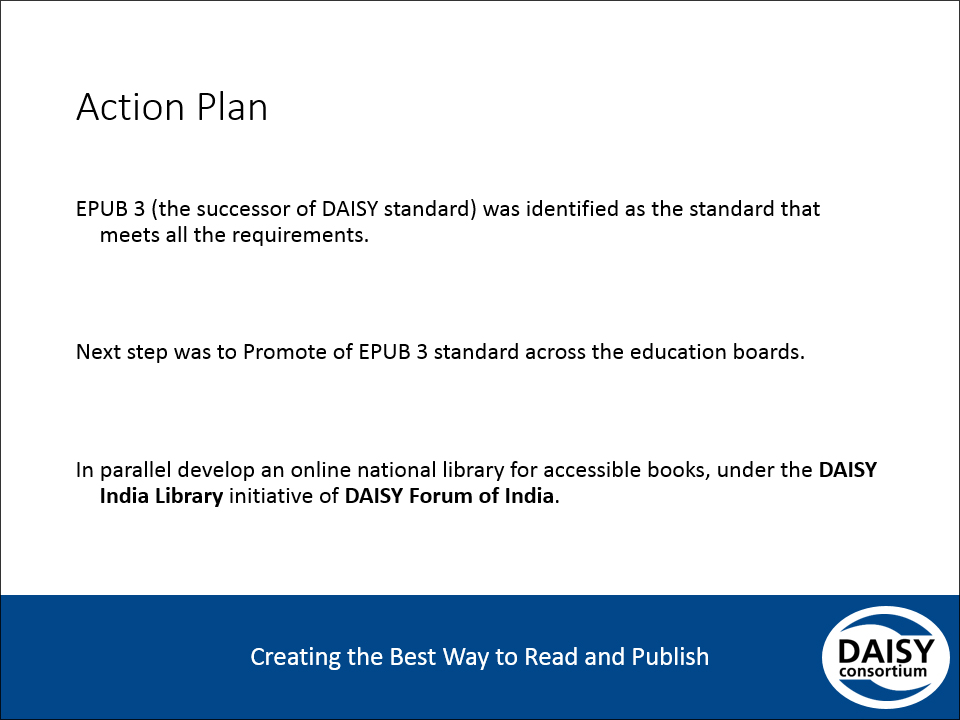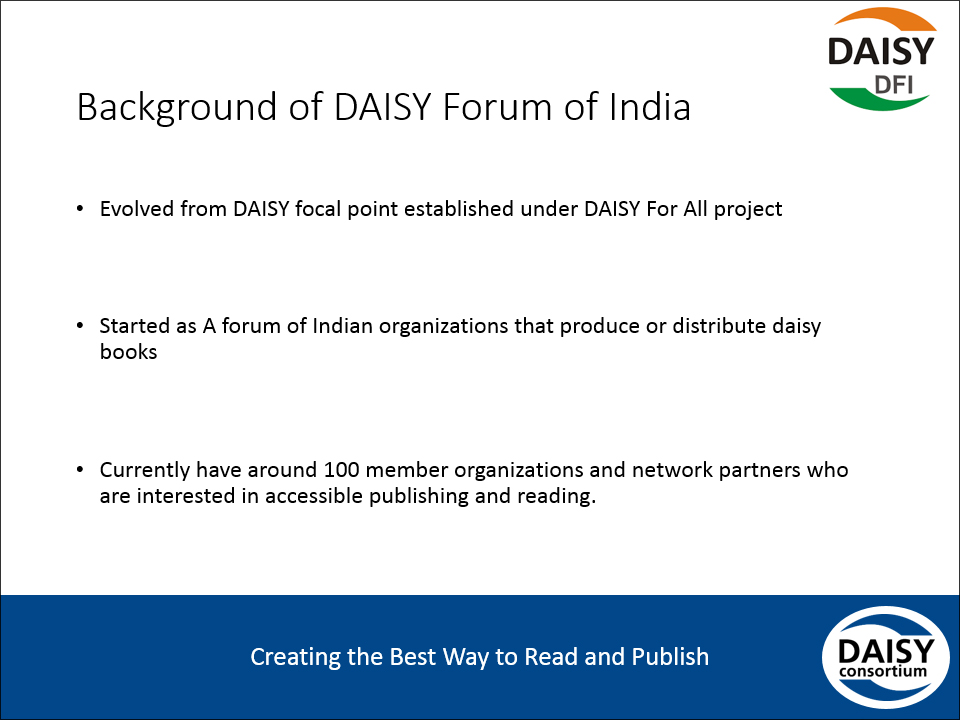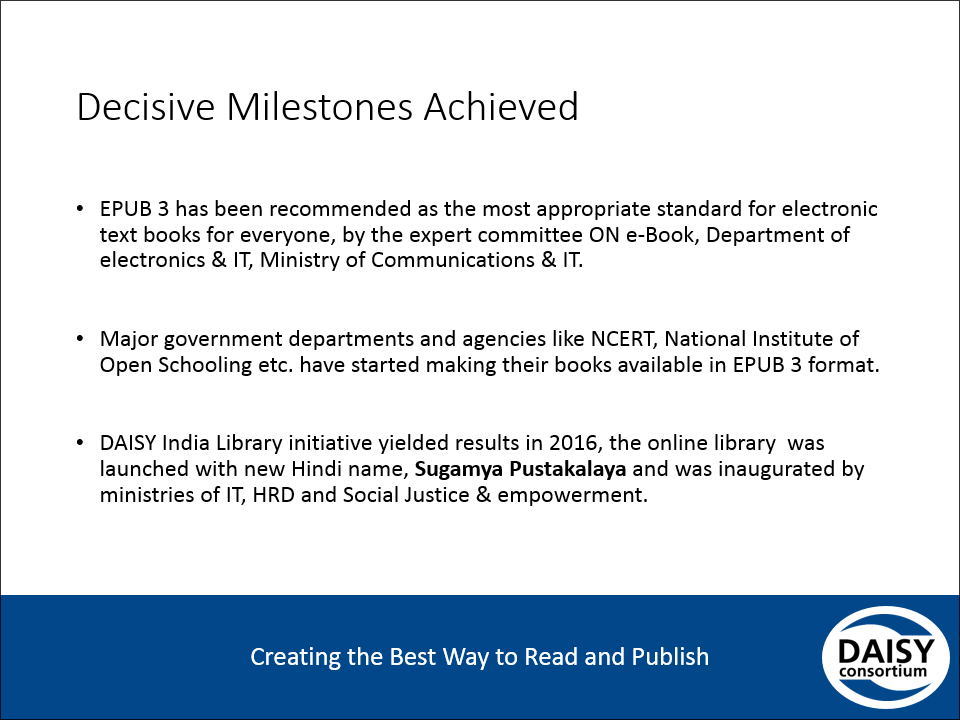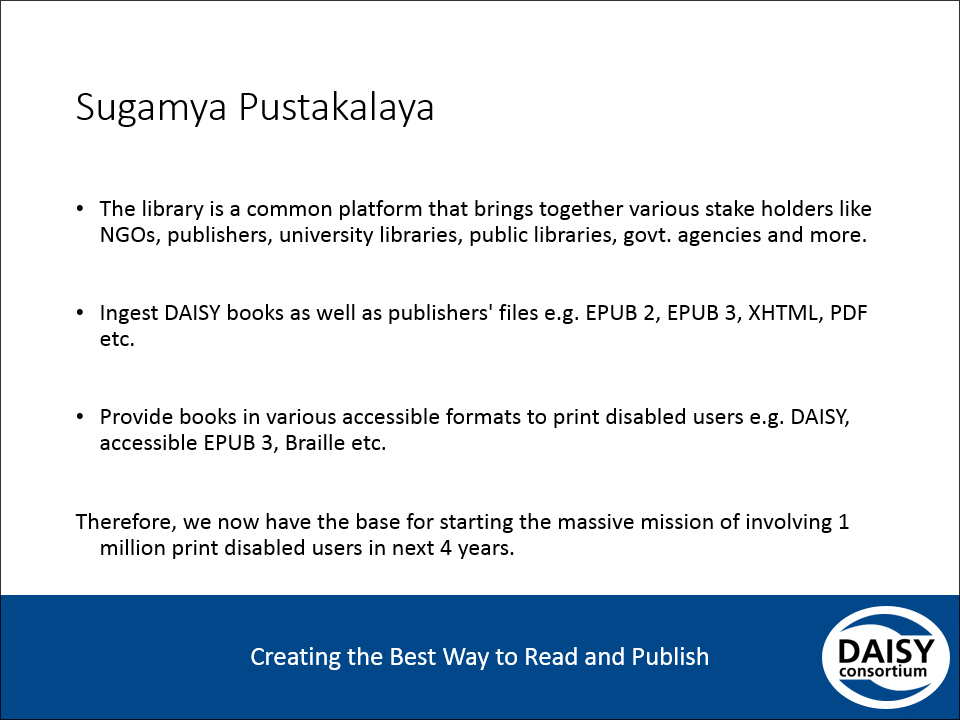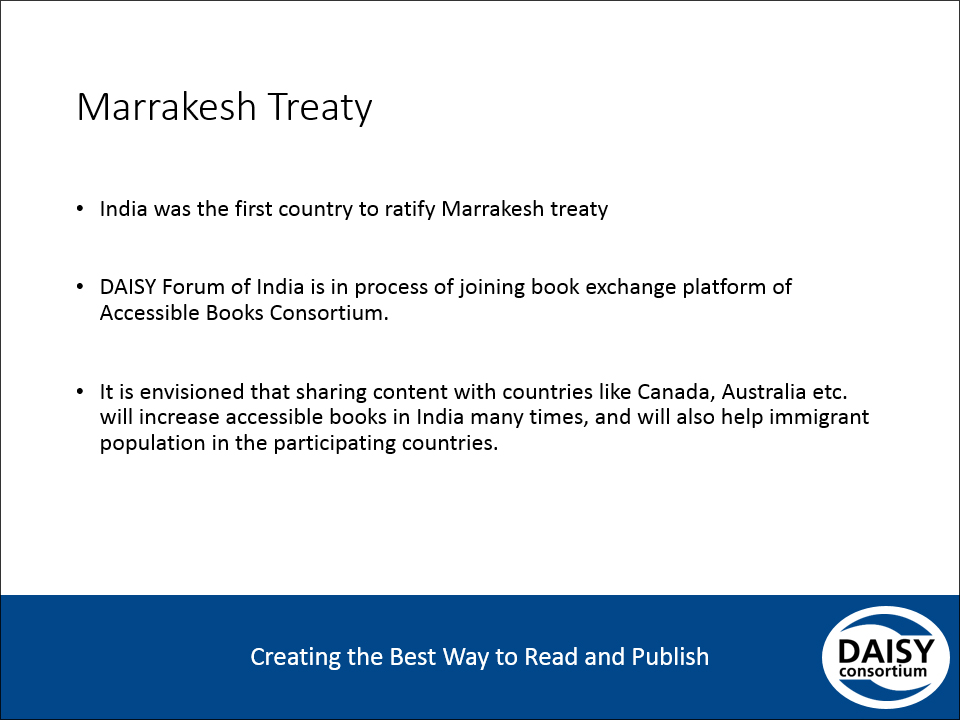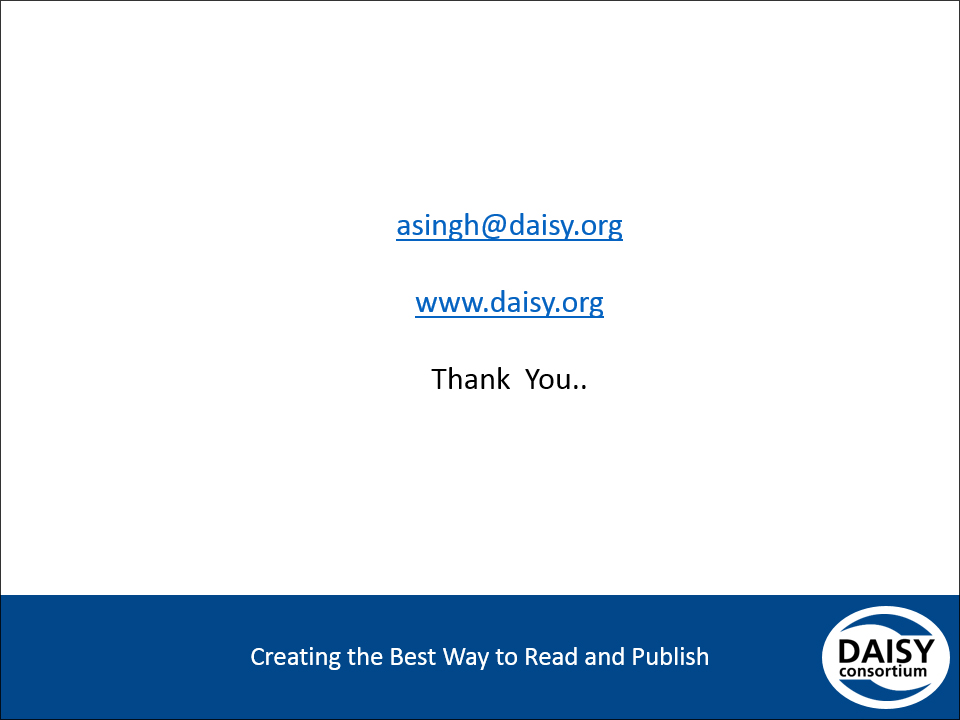Panel Discussion -Learn from the approach in England, Norway and India-
Richard Orme Chief Executive Officer, DAISY Consortium- The United Kingdom of Great Britain and Northern Ireland
Arne Kyrkjebo Head of Development Department, Norwegian Library of Talking Books and Braille (NLB)- Norway
Avneesh Singh Chief Operating Officer, DAISY Consortium /Co-Chair, EPUB 3 accessibility working group- India
Richard Orme
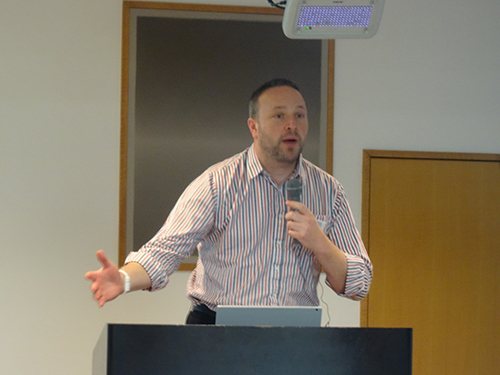
●Thank you very much, it's wonderful to be here today.
So I'm going to tell you a little bit about the experience in the UK, which starts with a story around students with sight problems, but ends with a great story for all students with learning disabilities and print disabilities including those with dyslexia and other problems.
Now around 10 years today, when I was working at the Royal National Institute of Blind People, we were hearing a lot from parents, from teachers, and from students, about how they were getting their textbooks late in the format that they needed. They were finding that they were getting the wrong edition of the books so they were learning with a different version of the textbook than their other classmates, or they weren't getting their textbooks at all. And this was the case for students with sight problems, but for students with other print disabilities, there was little or no provision at all. And the technique for providing accessible books for students with print disabilities was all based on taking books that were produced on paper, and turning them back into electronic versions. So books that had been created on a computer and then printed out then were being turned back into electronic documents by hard-working people in schools. And there was very little coordination other than at the district level, to really maintain that the same book wasn't converted multiple times.
So we were hearing this a lot from parents, and from teachers and from the students themselves. So we commissioned some research, which was published almost to the day 10 years ago. It was called "Where's my book?", and it was about tackling the textbook deficit that was faced by school pupils and sight loss.
When we spoke with the government about this problem, they said, "If this was an issue, we would have heard about it." So we wanted to provide them with the evidence that it was indeed a problem. And the evidence showed us that for example, none of the atlases or the dictionaries that were widely used were available in any accessible format. Less than three percent of math or science titles were available in large print, for example. And when we asked teachers about what difference they thought this made for their learners, they said that the delays experienced had a large, or at least some effect on the social inclusion and the educational development of learners.
Now sometimes for large print, the approach was to take a regular print book and use a photocopier to put it onto bigger paper. This was very widespread practice. But one of the learnings we had from this research was that students really hated this approach. They had these big pieces of paper, they didn't fit on the desk, they didn't go in their bags, and it immediately marked them out as different from their friends. And actually, often it wasn't even big enough anyway. So pupils, parents, teachers desperately wanted a better approach.
The government told us that if there's a problem, they would've heard about it, so we made sure they did hear about it. On this projector here, there's an image of some young children and there were over 100 children and their parents who traveled down to London, to the famous Houses of Parliament, with Big Ben. And there's a photograph of them here, standing there with their placards, their signs, saying "Where's my book?" And when you travel down to parliament, you can then ask to meet with your member of parliament, who then has to come out of their office and come meet with you in historic hall. And all of these members of parliament were coming down and meeting these students who were really, really good at explaining the problems they were having. Each of these students had two parents who both were voters; they make votes for these members of parliament, and so they really heard this message.
And so before long, the minister who is responsible for education, he issued a statement, which said "We're not satisfied, actually, that the current system of making textbooks available for children who can't read print because of visual impairment or dyslexia, is working." He credited the campaign with having brought this to the attention of government and recognized that providing materials in accessible, electronic form was the answer. And they committed that the government was going to lead work to bring this about.
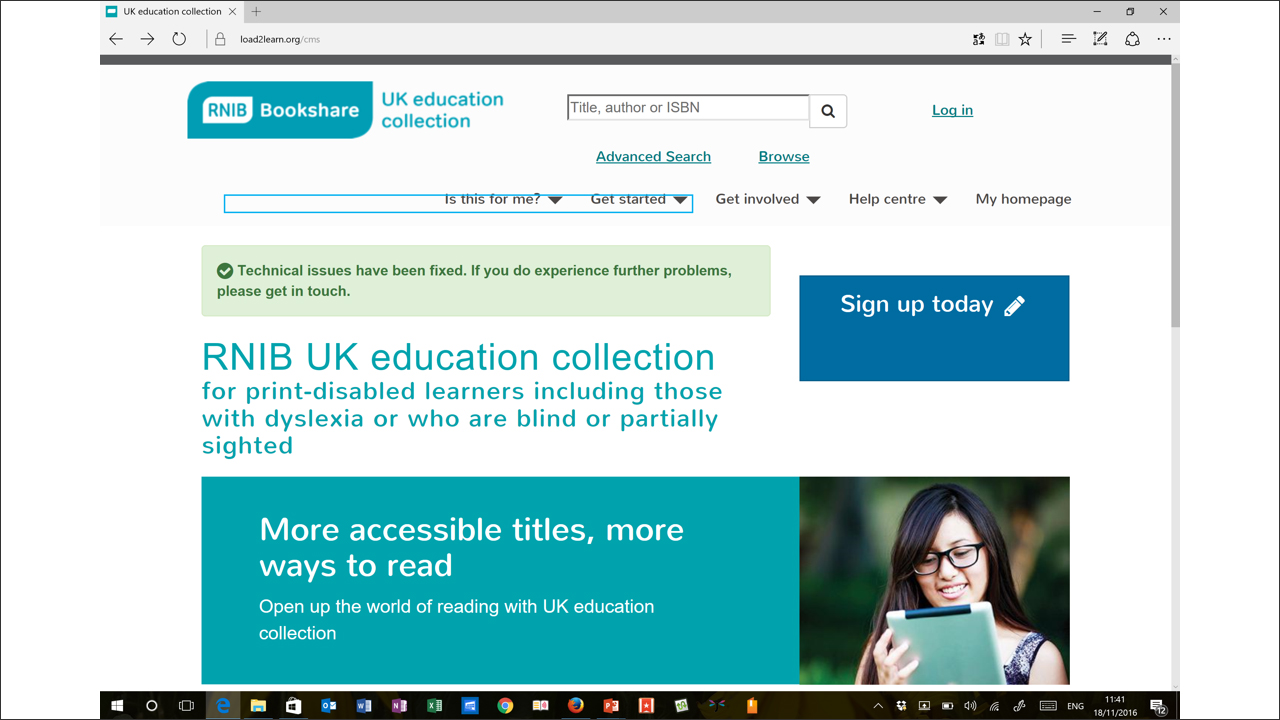
So where are we today, then? Well here's a website that is in the UK, it's called the RNIB UK Education Collection, beforehand it was called "Load to Learn," because it loads textbooks into it and then students can then learn. It comes from the organization that's leading this work, RNIB, but it's for all students with dyslexia and other print disabilities. So my son, for example, who studies with dyslexia, he's able to download textbooks, and read them on his tablet or his computer. And my brother who struggled with severe dyslexia all the way through his school years, he would have loved to have had a solution such as this.
Now in the corner of this website, there's a little logo, and it says "RNIB Bookshare." You heard earlier from Brad, from Benetech, about their Bookshare initiative, and how they collaborate around the world. And here's a great example of international collaboration, because rather than reinventing new technology and new solutions, we're stealing or borrowing the best ideas from other countries, and we're concentrating on the challenges that are specific in the UK.
So today, we absolutely continue our collaboration with publishers who really enjoy this solution. Rather than having angry letters from parents, or desperate letters from teachers asking for the title and saying "Please can I have this in large print?" or "Can you send me a file?" they know that there's a solid, trusted solution, that if they send the file to the education service here, then they have it fixed, and they know that access to these files is controlled for only learners with print disabilities.
It's only education titles, really, that are on this website, and when I checked earlier today, there are more than 17,000 titles, and these are all books that are used today in schools. And if there's a book that's missing built into the system, it's possible to make a request, which is then handed through to the publisher; and going from when people struggled and struggled for maybe a year to get hold of a textbook, we've got examples of where a teacher makes a request and it's on the system before the next day is over. Really, really fast turnaround. And the publishers like to compete to see how fast they can get their books on the system. It's great.
There are over 3,000 accessible images on here as well. So these are titles, and Martin referred to these images which can then be printed out and made into a tactile diagram, covering common educational concepts, such as how the blood flows around the heart, how the rainwater goes into the clouds, onto the mountain and into the rivers and into the sea; these concepts that are common, used again and again, which before, teachers were doing each time in their own schools. There are 3,000 accessible images that are actually available internationally, as well.
There's helpful guidance for teachers and for learners, and there's guidance, importantly, on copyright, and the responsibilities of those that are using the system, to protect the legitimate permissions that are needed, and the intellectually property that is loaded on the website.
So lessons: we found it was very important to have good evidence of the issues the students were facing and to recommend and ask for a solution that was identified by the very people who needed a solution.
Leadership from government was really, really important, and collaboration with publishers as we worked to find a solution together. We built the solution using open standards, and this too, is the approach that's used by the DAISY Consortium. We borrowed the very best ideas from other countries.
There's sometimes a model that is used to describe what's important for a learner with print disabilities to succeed in school. And this model is sometimes called "kit, content, and confidence." So by "kit", this is a piece of equipment, like an iPad or a smartphone or some of the equipment that's at the back of the room, which an individual learner is able to use to read their materials. "Content" are all these wonderful books that publishers produce available in an accessible form. And "confidence" is the training and the support the learners have in order to use these pieces of equipment and to really do their very best in their studies.
So students with dyslexia, with blindness and low vision, and with other print disabilities are succeeding in the UK today, and this is our experience. By the way we're using some Japanese technology for this, so we have borrowed from Japan, and if there are any lessons in our experience from the UK that you can borrow from us, you're very welcome, for us to return the favor.
Thank you very much.
Arne Kyrkjebo
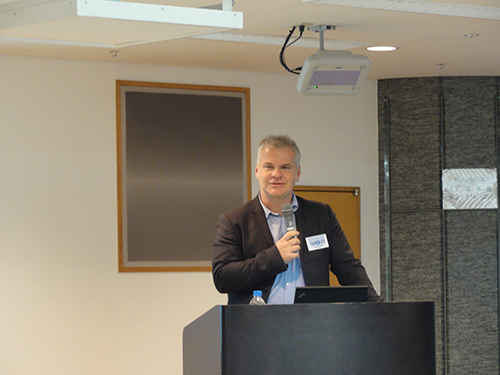
●Hello, everyone. Thank you for providing this possibility to give a very, very brief description of the situation for students in Norway when it comes to textbooks.
First, I represent the Norwegian Library of Talking Books and Braille, NLB; we are a government library, providing library services for people with reading problems. We are under the Department of Culture and this is because we are a part of the public library sector in Norway. All the services at NLB are free of charge, and we are located in Oslo, Norway. We are a national provider.
We have two main services: one is to have a public library service, serving what you should expect to find in a public library, but of course in an accessible format. That is one of the services. The other one is to provide textbooks for students in higher education. We provide services based on what kind of handicap you have. Those that are visually impaired have something that we call a "production right." That means that they have the right to have their material produced. So if you don't have it in the collection, you produce it. If you have reading problems, dyslectic, etc., you have a "lending right," that means that if we have the content, you can borrow it, if we don't have it, we have to say we are sorry. This is not due to a lesser right for dyslectic; this is due to our finance situation, and the fact that we used to be a library for the blind, which is some kind of core group. I'll a get back to that in a bit.
So, in Norway, it's the university that has the responsibility to provide the students an accessible learning environment; it's not NLB or others, it's the university. So they do a lot of services at campus, support, tools, access to content, do minor production, etc., this varies from university to university, of course, but they have the responsibility, and we cooperate with them, with a lot of things, but one of the things is to provide the textbooks.
We have, for the last years, focused mainly on increasing volume and reducing the production time. This was due to little production and the production time being too short. We had a lot of examples where the students got their books after the exams; that's too late. So we have, during the last years, focused on making things efficient - inefficient, efficient.
One of the things we have done is we have implemented EPUB 3 in our system, but at this point, it's only what we call a source file. That means that the EPUB 3 file is the source for all the production flows we have, and the different end products that we have. The EPUB 3 files are produced in India; Maarten Verboom had an earlier presentation about their production flow, and it's similar. It's very, very quick, of course, it's much quicker if, like Maarten talked about and Brad talked about, we could get the content from the publishers in an accessible way, or they could have done it themselves, but at this point it is very, very efficient. We get the PDFs from the publishers, send them to India, very, very quick production, receive the EPUB 3 file, and produce the content. 85 percent of the audio book is now based on TTS, full textbooks with speech synthesizer, and we also produce a lot of eBooks in HTML format. Everything is automated. That means that for students, it could go down to two to three days to produce a book, including this whole line, and earlier it could mean in worst cases, perhaps six months when we have narration.
So it's much better than it was, but not good enough yet. The problem is that the quality is not good enough. It's very, very efficient, and the quality is not good enough. There are a lot of things, for instance the TTS can't cope with all kinds of content, it's hard to handle all the complex content, Brad had a very, very good description of that, Maarten also, so it's kind of the same problem, that is still a problem.
One of the great things that happened in Norway lately, is that we have gotten this mandate from the Department of Culture and the Department of Education. If you remember at the beginning of the presentation, I said that the dyslectic had a lending right and the visually impaired had a production right. What they want us to do is evaluate the consequences, if dyslexic students got the same services as the visually impaired get today. For us this is a very good opportunity, because they want a report, and the report should analyze the situation and it shall analyze their needs, and it should suggest solution. Since the report shall be finished and delivered in March 2017, it is a little bit difficult for me to give the results, but we see a lot of potential in this. The first one is that there is a focus in the two departments about this, and we know that this will mean that there will also be a focus on the other group. We hope that this also means that they will have equal rights, that means we will also be able to serve their needs better.
Norway's not a big country; the population is about 35 percent of Tokyo's population so it's not that much people, but still, you saw the numbers from Maarten, you saw the numbers from Brad, they talked about 90 percent of print disabled people being dyslectic; we have the same. So today, we are serving a very, very small group compared to what we might be serving in a couple of years when this mandate has been given, which hopefully will be accepted and approved, and hopefully will also include some funding.
2017, a better service for a larger user group. There have been many fantastic presentations earlier today, talking about all the possibilities in the new standard EPUB 3 and so on, so I don't have to repeat that, but one of the things we really want to have is more knowledge about different user groups. Of course, one of the new user groups, in a way, is the dyslectic. They haven't been getting the same services as the blind; now we can really get their needs to see if they have different needs and how we should cope with that.
Also in 2017 we will migrate to EPUB 3 for our textbooks, that means that the distribution format also will start to be EPUB 3, and I think the reason why has been given very, very well today. We see that all kind of possibilities, all the things we lack today will be in that standard.
We are also working all the time with the relation with the publishers and the university and this is kind of improving but we better see that there are a lot of challenges when it comes to the textbook files from publishers. The other thing is that 40 percent of the books in Norwegian universities are not from Norway, they are English books or American books.
One of the things that we are going to try in 2017 is the combination of TTS and narration in audio books. One of the things which is a problem today is that there are two different production lines, either you do narration, or you do TTS. And actually, we think the optimal thing is to have a combination. That means that we are planning to produce TTS books for everything, all the audio books should be with TTS and we will add narration where we see that TTS is not good enough for the content.
So that is one concrete thing that we will do in 2017, which will improve our books dramatically. That's it.
Avneesh Singh
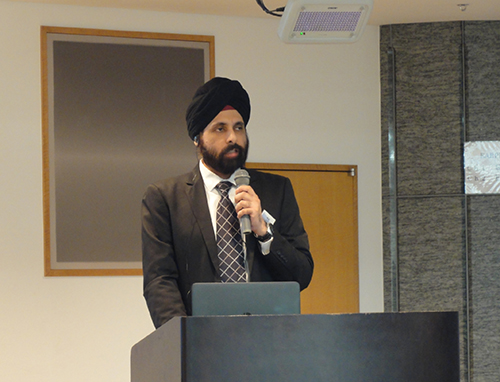
It's great to be in Tokyo again, thanks to the Japanese DAISY Consortium, the JSRPD, and Nippon Foundation for giving us an invitation to present here. So my presentation is from a little different level, it is a slightly different contrast, as compared to the presentations that you have seen today, because the presentation comes from India: the country where everything works at a massive rate. So our challenges for people with print disabilities are also at a massive pace. Let's see what challenges are in front of India.
In India, we have a huge target. There are about 12 million people with print disabilities; the people with visual disabilities are about 5.3 million, and the other count includes people with cognitive disabilities and other disabilities with which there is a problem reading the paper books, the traditional kind of books. Out of this 12 million, only 50,000 is the population to which we are able to reach. It includes the outreach activities of both the NGOs as well as the government. So we are able to facilitate, we are able to provide the accessible books only to 50,000, whereas the total number of print disabled is 12 million. So no doubt, only one percent of the published material, in fact less than one percent of the published material available in India, is available in the accessible format.
So one thing comes to mind; why it is so? What's the reason for such a gap? The reason is the approaches are fragmented. The textbook is really a fragmented kind of condition in India, there are many school boards, there are central boards of education, and there are state boards of education. The course curricula of all the boards differ from one another. Sometimes we even see that there are more than one textbook curriculum in a single state. The publishers are also fragmented. Some of the books are produced by the government publishers, while there are a series of other publishers who are producing their textbooks, which are recognized by the state boards. And the government of India historically supported only the Braille format as the official format for people with print disabilities.
So what is the solution for such a problem? The solution of fragmentation is to bring everyone on to a single platform. If everyone is on a single platform, then all these inconsistencies can be overcome. But how is it possible? It is only possible if a single standard is followed, and all the boards, all the textbook publishers follow the same standard. But we cannot follow any standard. There are requirements that the standard has to fulfill.
The standard should address the need of different kind of disabilities. It should provide a great reading experience with eyes, ears, and fingers. The standard should support the creation of a single master copy. It is not possible that we create 10 or 15 master copies for people with different kinds of disabilities. There should be a single master copy that can be convertible into different kinds of books which are suitable for different kinds of disabilities.
And last one, but one of the most important ones, the standard should support all the Indian languages. We have 22 recognized languages, plus there are many regional languages, so the standard should definitely support the multiple languages.
So what is the action plan? The strategy that we created was, firstly identify the suitable standard, because without a standard, this fragmentation cannot be overcome. So find out which is the most suitable standard. And EPUB 3, the accessible EPUB 3, was the standard that met all these requirements.
The next step was to promote EPUB 3 as the appropriate standard for textbook publishing across the school boards, the central boards. But this was not enough. After the standard, we also needed to work on a common platform. So, in parallel, we planned the creation of an online national library, an online repository of books where they will be placing all the accessible books of the country, and from this single source, people with print disabilities will be able to get the accessible books. And this initiative was taken by DAISY Forum of India. Let me talk a little bit about DAISY Forum of India.
DAISY Forum of India evolved from DAISY focal point, which was set up under the DAISY For All project, generously funded by Nippon Foundation, thanks to them. It started as a forum of some organizations that used to produce DAISY books and used to distribute DAISY books in India. But now, it has expanded to more than 100 members, and there are partners that span throughout India from the north to the south state of Kerala, and from Gujarat to the eastern state of West Bengal. So this was about DAISY Forum of India. And let's now see what the results of the action item that we took were.
The decisive milestones achieved. EPUB 3 has been recognized; there was a major recognition of EPUB 3 in the government. An expert committee under the Ministry of IT and Communications recommended EPUB 3 as the most suitable format for people with disabilities, as well as students in the mainstream. So it is the standard recognized by the expert committee under the ministry, the suitable standard for all. The major government departments and publishers like NCERT and the National Institute of Open Schooling, these major departments started providing books in EPUB 3 format.
And the third one, the initiative for the DAISY online library, this initiative yielded really good results. On the 24th of August, 2016, a couple of months ago, the online library was launched, with the Hindi name, Sugamya Pustakalaya. And this was inaugurated by three ministries, jointly: the Ministry of IT, the Ministry of HRD, and the Ministry of Social Justice. So this initiative was completely backed by the government of India.
Now a little bit about the national DAISY online library; it is the platform that brings along all the stakeholders. The stakeholders include the publishers, the NGOs that are creating the DAISY books, the public libraries, the university libraries, and also the government agencies, so we have the support of government. This library can ingest the books in the DAISY format, and also the publisher files in EPUB 3, EPUB 2, and also in PDF and maybe other formats the publishers have. And it can provide the books in accessible format, for example DAISY, EPUB 3 and also Braille. So they import the files from different sources and different formats and provide the output in the accessible format, and the print disabled users can directly download these files from this library.
Therefore, now we have a great pace for taking this massive movement forward, and the next target for us is to outreach, to include, to involve, one million print disabled in the next four years. So this is how we are placing everything in place the local way, inside India. In parallel, we also have the collaboration with Bookshare, so the online library is also connected to Bookshare, and we are looking forward to the outputs, to the outcomes of the Marrakesh Treaty.
A little note about that: India was the first country to ratify the Marrakesh Treaty. And DAISY Forum of India is in the process of participating in the book exchange platform of the Accessible Books Consortium. And we hope, and we are very optimistic, that once this book exchange starts internationally, the availability of accessible content in India will increase many times, and this will also benefit the immigrant population of India which has moved to other countries like Canada, Australia, and the United States.
So this was the overview, the strategic initiative of India, where things are taking shape in a massive way, because the challenges are massive.
Thank you.
Panel Discussion
- Kawamura
- ●Thank you very much, Avneesh, and we are now going to have a very brief wrap up discussion. So we have just 10 minutes. Richard and Arne, please come forward. We are going to have a very short wrap up discussion of this panel due to the time constraint. We have simultaneous interpretation, as well as real-time captioning both in Japanese and English, and these supporting people can support us until 4:30.
Okay, so this is the session for the so-called panel discussion. And what I would like to ask each of the panelists is, in your milestones, how do you react to the DAISY Consortium initiative on EPUB accessibility 1.0 introduction and the certification system? I would like to know your comments on these two issues based on your country's situation. So, starting from Richard?- Richard Orme
- ●I've had the great opportunity to talk to publishers on many occasions in the UK and actually in other countries too, about the concept of an accessibility baseline for EPUB, and I can tell you that without any exception, it's always been very warmly welcomed by publishers, especially, and they see this as solving the problem that they face.
And I suppose from the perspective of a service like the RNIB Education Collection, and what that brings to learners with all sorts of reading disabilities, there are two things: one is that the files that are able to go into a service such as that will come in with better structure, and better semantics, and a baseline of accessibility, which Maarten and others spoke about, and will really improve the efficiency and the experience for customers.
But it brings another really, really important thing, too, which is that the students won't necessarily have to go to a special service such as the RNIB service because those titles, if they have that baseline of accessibility, will be available through the mainstream channels as well. So no thing is a silver bullet that solves every single thing, and one individual learner won't choose a single solution, but for learners to have a choice, of being able to go to a special service for some things, and to get their books and titles from the mainstream, is a very, very powerful thing, that's really important for the confidence and self-esteem of learners as well, like my son. It's fine that he goes to a special service, but I know that as he goes through his education, he will want to get the same books, from using the same system as his mates, as his friends, so it's important for that as well.- Arne Kyrkjebo
- ●If I can add just a little bit to what Richard said, of course I agree with everything he said, I think one of the good things is that it's showing also that today the EPUB standard is going forward. So it's a kind of improvement, it's a development, it also addresses the issues that we try to tell the publishers, so one thing is that it's mainstream but also it takes care of other issues. I think it will be easier to sell in the standard to the publishers.
- Avneesh Singh
- ●On our side, we have already started policy implementation, during the launch of the DAISY online national library, the Sugamya Pustakalaya. The ministry promised us that they will be creating the council for accessibility, and in this council, we have plans of getting the accessibility baseline into the policy for the electronic textbooks.
- Kawamura
- ●Thank you very much, and if you have some concerns about the reaction from the publishers in your country, please say it in a brief manner. Do you feel confident that publishers will eventually accept the EPUB 3.1 accessibility and the certification in each country? How do you think? Avneesh?
- Avneesh Singh
- ●There are bureaucratic challenges on the government side, but this initiative comes from the government, actually. If the government makes a policy that all the textbooks in the country has to meet this specification, publishers will definitely meet the specification. This is what the experience says. But at the same time, there are some publishers who are coming forward for it, there were some publishers, about three months ago, when we said that we were near to completion of the accessibility baseline, who came themselves asking us, please tell us how should we update our processes according to it?
- Kawamura
- ●Thank you. Richard?
- Richard Orme
- ●I was lucky enough to be in Frankfurt last month for the Frankfurt Book Fair, which is this huge, huge event, and we talked there about accessibility, and there were many publishers in the audience, and the concern actually that came through was that they put a lot of effort into making their textbooks great products, and they wanted to make sure that the reading experience for the pupils was also a good experience. They were concerned actually more about the reading solutions.
But actually I think we have a lot of evidence for why we should feel confident about that, because it's a market place, and we see every day, today, even, great announcements about big companies getting behind EPUB to produce great solutions that are low cost, and maybe even free, and on everyone's desktop. So actually, the reading solutions are coming very, very fast, they'll be scaled up by companies that are targeting customer groups of millions if not billions of customers. This is the advantage of moving to a mainstream accessible format that serves everyone. So that was the concern from publishers but it's a great opportunity.- Kawamura
- ●Arne?
- Arne Kyrkjebo
- ●Now that doesn't make me more concerned. My concern lays on other fields, to be honest. We had this survey, we have been checking the digital textbooks available in Norway, and when we looked at that, the biggest concern is actually that they are choosing different standards, or their own standards, or non-standards. So I think the focus is to work on selling in the standard.
- Kawamura
- ●Thank you very much.

